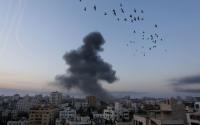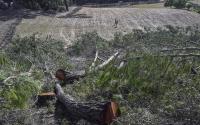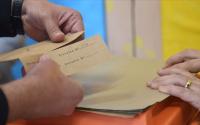10 September 2003
We do our best for the world's poor. Perhaps our aid budgets are not as large as they could be, but we do what we can. Wrong. Through the complex web of taxes, tariffs and quotas that governs trade we take far more from the poor than we give them. For every $1 we give in aid, we take $2 through unfair trade. Unfair trade costs the world's poor $100bn a year. Today, ministers from around the world begin a five-day World Trade Organisation meeting in Cancun, Mexico. There are terrible inequities that need to be addressed if the 2.7bn people in the world who live on less than $2 a day are to be enabled to stand on their own feet
THE STARTING POINT
Poor countries hold 40 per cent of the world's population, but receive only 3 per cent of the world's income from trade. Rich countries make up 14 per cent of world population and yet get 75 per cent of the profit from trade. The world's poorest region, sub-Saharan Africa, has recently seen its share of world exports fall from 1.2 to 1 per cent. Britain makes more from trade than South Asia and sub-Saharan Africa combined.
AN ISSUE OF TAX...
The import taxes imposed on goods from developing countries are four to five times higher, on average, than tariffs applied on trade between rich nations.
A shirt made by a worker in Bangladesh attracts 20 times more import tax when it enters America than goods imported from Britain.
Clothing, India's second largest export to the US, is taxed by Washington at 19 per cent. Imports from countries such as France, Japan, and Germany are charged at between zero and 1 per cent.
Catfish farmers in Mississippi have secured protective tariffs of more than 60 per cent against catfish imports from Vietnam. The average tax rate on Viet- namese goods entering the US is 8 per cent. For Dutch goods it is just 1 per cent, which means Vietnam - a country with 81 million people living in poverty - pays more in US customs duties than the Netherlands which exports four times as much to America.
... AND OF DISCRIMINATION
The more value the poor try to add to their goods, the more the tariffs escalate. Raw cocoa beans can be imported to the EU and US without tax. But if the poor process it themselves into cocoa butter the rate in the EU goes up to more than 10 per cent. If they turn it into cocoa powder it is more than 15 per cent. If they turn it into chocolate it's more than 20 per cent. This explains why Germany processes more cocoa than Ivory Coast, the largest producer; and why Britain grinds more cocoa than Ghana. Developing countries produce 90 per cent of cocoa beans, but less than 5 per cent of chocolate.
TRYING TO BREAK FREE
Brazil estimates that it could earn $10bn more from agricultural exports this year were it not for trade barriers in the West. Lifting restrictions on Mozambique's imports into the EU would boost the country's earnings by almost $100m a year - nearly as much as it receives in European aid.
SUBSIDISING THE RICH
Rich governments now spend $1bn a day on subsidies to farmers - six times what they give in aid to poor countries. These subsidies generate large surpluses of sugar, cotton and other products, which are then dumped on world markets.
There, they are sold for less than it costs to produce them, meaning that Third World farmers cannot compete with the prices and go out of business.
Europe produces sugar at three times the price that more efficient countries such as Malawi and Zambia do. At the same time, rich countries spend more on farm subsidies than Africa has for its entire GDP.
America's 25,000 cotton farms receive more than $3bn a year in support. The International Cotton Advisory Committee claims these subsidies lower world prices by about 25 per cent.
GUESS WHO PAYS?
The average European family pays more than $1,000 a year to the continent's richest farmers and agribusinesses under the Common Agricultural Policy.
WHO BENEFITS?
In 2001, the poorest 50 per cent of US farms received a mere 5 per cent of government agricultural payments; the richest 7 per cent accounted for half of total payments. In the EU, 5 per cent of farms receive half of total Common Agricultural Policy (CAP) subsidies. The biggest beneficiaries of the CAP in France include some of its richest farmers, while one quarter of French farms receive nothing. Large sugar farms in Britain receive annual subsidies of £60,000 (€86,000) each.
EMPTY PROMISES
Under the reform package adopted by EU member states in June 2003, overall spending on the CAP will be maintained at current levels - about €50bn (£35bn) - adjusted for inflation, representing almost half of the current EU budget.
But the new CAP deal will have little impact on export dumping. The dairy and sugar sectors, which between them account for two thirds of direct export subsidies, have been left largely untouched.
BROKEN PLEDGES
The round of World Trade Organisation negotiations that began in Doha in 2001 was supposed to be the first time that developing countries had been placed at the centre of multilateral trade negotiations.
It promised to phase out subsidies by rich nations to their farmers, reduce or eliminate tariffs and other technical barriers and give access to medicines for all. Almost two years on, none of the promises has been honoured.
The EU and the US, the world's farm-subsidy superpowers, promised in Doha to cut agricultural export subsidies. Since then, both have done the opposite, increasing subsidies to their biggest producers. About half of US support is now exempt from WTO rules.
Sources: World Trade Organisation, World Bank, US Dept of Commerce, Oxfam, DfID, European Commission, Brazilian Government, OECD, World Development Movement
http://news.independent.co.uk/world/politics/story.jsp?story=441912






